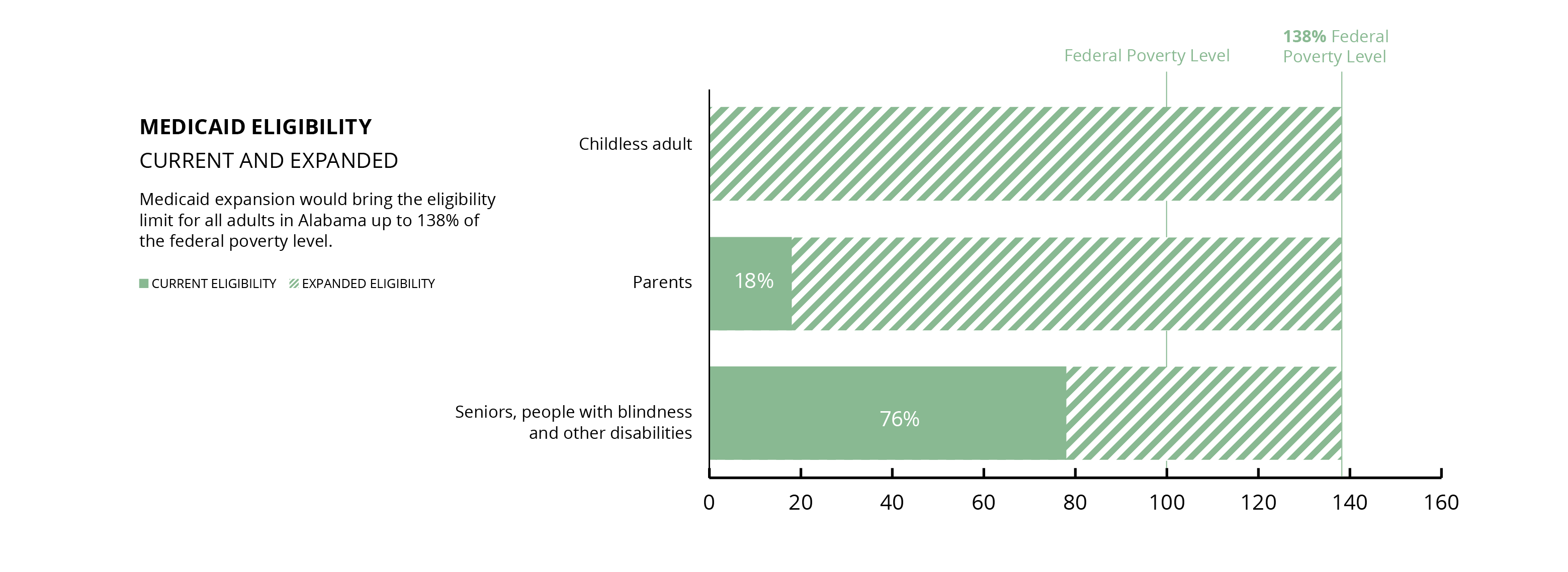MEDICAID EXPANSION
What you need to know …

- Medicaid expansion would help hundreds of thousands of Alabamians get the health care they need.
- States that have expanded Medicaid have seen improvements in infant and maternal mortality and greater access to treatment for mental illness and substance use disorders.
- Extending coverage would reduce Alabama’s racial health disparities.
- Medicaid expansion would generate billions of dollars in economic activity and hundreds of millions of dollars in new tax revenues.
- Expanding health coverage would boost efforts to make Alabama’s prison system more humane, restorative and cost-effective.
- Medicaid expansion could save hundreds of lives in Alabama every year.
Closing the coverage gap would improve lives
Hundreds of thousands of Alabamians could get the health care they need to survive and thrive if Alabama raised the income limit for Medicaid and allowed coverage for adults who aren’t parents. Medicaid expansion improves lives across a range of health measures, a growing body of research shows. Those areas include better birth outcomes and maternal health, lower overdose rates and improved mental health. Expansion also would increase household financial security and reduce racial health disparities.
Extending coverage would keep Alabamians healthier
- Evidence from Medicaid expansion states shows that providing women continuous health coverage before, during and after pregnancy would make a life-saving difference for mothers and babies.
- Extending Medicaid coverage to adults with low incomes would extend the benefits of ongoing Medicaid reforms to hundreds of thousands more Alabamians. This improvement would give us the tools we need to address the state’s chronic health challenges, making families and our workforce healthier in the process.
- Research shows that Medicaid expansion increases access to treatment for substance use disorders and significantly strengthens responses to the opioid epidemic.
Medicaid expansion would promote racial equity
Alabama’s shameful legacy of segregation and racial discrimination has driven racial health disparities that continue today. Nearly half of uninsured Alabamians with low incomes are people of color, even though people of color make up just one-third of the state’s population. Medicaid expansion would reduce that coverage disparity and increase economic and health security for Alabamians of all racial and ethnic backgrounds.
Medicaid expansion would boost Alabama’s economy and budgets
In the first four years of Alabama’s Medicaid expansion, the federal government would spend $6.7 billion for new health coverage in our state. This direct investment would yield:
 Covering adults with low incomes also would save $316 million in current state health program costs. With all these gains, the net cost to the state would be:
Covering adults with low incomes also would save $316 million in current state health program costs. With all these gains, the net cost to the state would be:
IN FOCUS
Medicaid expansion would support prison reform in Alabama
In 2019, the U.S. Department of Justice put Alabama on notice that prison violence and overcrowding will trigger federal intervention if we don’t get the problems under control. Medicaid expansion would make our corrections system more humane, restorative and cost-effective in three ways:
-
- Untreated mental illnesses and substance use disorders are major contributors to over-incarceration in Alabama. By strengthening support for these services, Medicaid expansion would reduce recidivism and help more people stay out of the criminal justice system in the first place.
- When a person leaves prison, it’s hard to get a job that offers health coverage. But to get and keep a job, you need to be healthy. Medicaid expansion would provide former inmates the health security they need to join and remain in the workforce.
- Federal funding would cover 90% of the cost of expansion. That would slash state costs for hospitalizing prisoners and free up funds for other needed investments in the corrections system.
Medicaid expansion’s biggest win: saving lives
Across the country, Medicaid expansion saved the lives of at least 19,200 Americans aged 55 to 64 over the four-year period from 2014 to 2017. During the same period, 768 older Alabamians with low incomes lost their lives because they lacked health insurance. (Source: National Bureau of Economic Research, 2019)
If all states expanded Medicaid, the lives saved each year among older adults would nearly equal those of all ages saved by seatbelts.
SPOTLIGHT
Meet Formeeca Tripp

Formeeca Tripp watched her parents struggle with diabetes and heart disease. She has made efforts to follow a new path. But it hasn’t been easy.
“I have been conditioned to put my health on pause to make sure my children are up to date with all of their health care and mental health needs,” she says.
Formeeca lives in Auburn and is the mother of two children, one of whom was diagnosed with autism. She works full-time as a behavior specialist and part-time as an Uber driver to provide them both with medication they need, sometimes at a great cost to herself. For a long stretch, she fell into the coverage gap. With all her “extra” money spent on her children’s health care needs, Formeeca found herself reporting to work with ailments such as tooth infections and pink eye.
Recently, she gained coverage through her employer’s plan, but many people she knows are not so fortunate. Speaking from her own experience, Formeeca says Alabamians who can’t afford health insurance often work in public-facing jobs.
“It’s the people who are working with the sick and elderly, working with your babies,” she said. “It’s us, out here, hands on, making food, cleaning houses — it’s that gap of people, very important people. People who come into contact with thousands of other people. And you don’t want them to be healthy?”









